求助PDF
{"title":"Optimal Pricing and Energy-Sharing Strategies for a Commercial Building-Based Virtual Power Plant","authors":"Shunfu Lin, Hao Wang, Yunwei Shen, Hao Yu, Dongdong Li","doi":"10.1002/tee.70023","DOIUrl":null,"url":null,"abstract":"<p>As distributed resources within buildings continue to grow, buildings have had a significant impact on the stability of the distribution network. It's urgent to effectively achieve regional power balancing and consumption within building clusters. Virtual power plants (VPP) are believed to be effective in aggregating and managing distributed resources. In this paper, an optimal pricing and energy-sharing mechanism for the commercial building-based VPP is proposed to promoting power balance in building clusters. The virtual power plants operator's (VPPO) pricing strategy is determined based on the Stackelberg game, considering the cooperative game of lower-tier buildings with energy sharing. A LHS and Kantorovich-distance-based scene generation and reduction method is used to deal with the uncertainties of PV, WT, and load power in buildings. Then, an improved Shapley-value method is proposed to distribute the benefits of cooperation to the buildings. Moreover, a Shapley-valued-based carbon-credit apportionment method is developed to form the range of emission allowance for each building. The simulation results verify the effectiveness of the proposed optimal pricing and energy-sharing mechanism, which can promote the power balance among multiple buildings while reducing the carbon emissions of the VPP. © 2025 Institute of Electrical Engineers of Japan and Wiley Periodicals LLC.</p>","PeriodicalId":13435,"journal":{"name":"IEEJ Transactions on Electrical and Electronic Engineering","volume":"20 10","pages":"1557-1570"},"PeriodicalIF":1.1000,"publicationDate":"2025-04-17","publicationTypes":"Journal Article","fieldsOfStudy":null,"isOpenAccess":false,"openAccessPdf":"","citationCount":"0","resultStr":null,"platform":"Semanticscholar","paperid":null,"PeriodicalName":"IEEJ Transactions on Electrical and Electronic Engineering","FirstCategoryId":"5","ListUrlMain":"https://onlinelibrary.wiley.com/doi/10.1002/tee.70023","RegionNum":4,"RegionCategory":"工程技术","ArticlePicture":[],"TitleCN":null,"AbstractTextCN":null,"PMCID":null,"EPubDate":"","PubModel":"","JCR":"Q4","JCRName":"ENGINEERING, ELECTRICAL & ELECTRONIC","Score":null,"Total":0}
引用次数: 0
引用
批量引用
Abstract
As distributed resources within buildings continue to grow, buildings have had a significant impact on the stability of the distribution network. It's urgent to effectively achieve regional power balancing and consumption within building clusters. Virtual power plants (VPP) are believed to be effective in aggregating and managing distributed resources. In this paper, an optimal pricing and energy-sharing mechanism for the commercial building-based VPP is proposed to promoting power balance in building clusters. The virtual power plants operator's (VPPO) pricing strategy is determined based on the Stackelberg game, considering the cooperative game of lower-tier buildings with energy sharing. A LHS and Kantorovich-distance-based scene generation and reduction method is used to deal with the uncertainties of PV, WT, and load power in buildings. Then, an improved Shapley-value method is proposed to distribute the benefits of cooperation to the buildings. Moreover, a Shapley-valued-based carbon-credit apportionment method is developed to form the range of emission allowance for each building. The simulation results verify the effectiveness of the proposed optimal pricing and energy-sharing mechanism, which can promote the power balance among multiple buildings while reducing the carbon emissions of the VPP. © 2025 Institute of Electrical Engineers of Japan and Wiley Periodicals LLC.
基于商业建筑的虚拟电厂最优定价与能源共享策略
随着建筑物内分布式资源的不断增长,建筑物对配电网的稳定性产生了重大影响。如何有效地实现建筑集群内部的区域电力平衡与消费,是当务之急。虚拟电厂(VPP)被认为是一种有效的分布式资源聚合和管理方法。本文提出了一种基于商业建筑VPP的最优定价和能量共享机制,以促进建筑集群内的电力平衡。基于Stackelberg博弈确定虚拟电厂运营商(VPPO)的定价策略,考虑下层建筑的能源共享合作博弈。采用基于LHS和kantorovich -distance的场景生成约简方法处理建筑物中PV、WT和负荷功率的不确定性。在此基础上,提出了一种改进的Shapley-value方法,将合作收益分配给各建筑。在此基础上,提出了基于shapley值的碳信用分配方法,形成了每栋建筑的排放限额范围。仿真结果验证了所提出的最优定价和能量共享机制的有效性,该机制能够促进多栋建筑之间的电力平衡,同时降低VPP的碳排放。©2025日本电气工程师协会和Wiley期刊有限责任公司。
本文章由计算机程序翻译,如有差异,请以英文原文为准。

 求助内容:
求助内容: 应助结果提醒方式:
应助结果提醒方式:


